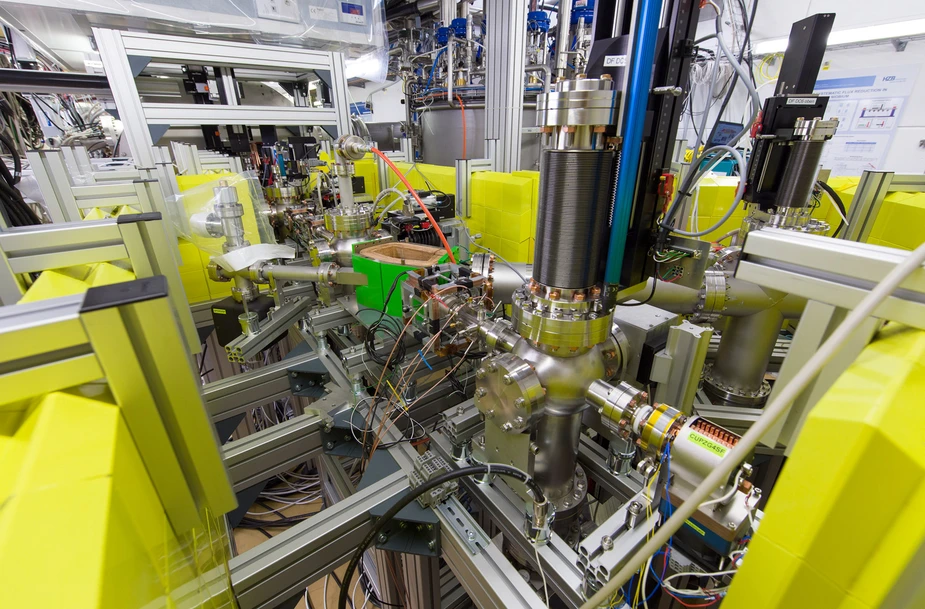Milestone reached: electron source for bERLinPro produces its first beam
Components for linear accelerator tested successfully
On the HZB Adlershof campus, researchers are building a prototype of an energy-recovery linear accelerator (bERLinPro). Intensive research has been going on for years to develop the worldwide unique key components required for this accelerator. Now, the scientists and engineers have reached a very important milestone: from the interactions between cathode, laser pulse and electric field inside the cavity, the first electrons have been produced and accelerated.
Over recent months, the researchers have developed and built to testing maturity four essential components for producing the electron bunches: a potassium-caesium antimonide semiconductor photocathode; a laser that fires light pulses of different wavelengths and durations at this cathode; a superconducting high-frequency cavity in which electromagnetic fields accelerate the bunches to near light speed; and a beam diagnostics beamline for precisely measuring the important beam parameters. These components have now been combined together and tested successfully in the GunLab, a 75-square-metre laboratory.
Producing electrons with a high power laser and photocathode
In charge of the photocathode is Julius Kühn. With his team he has investigated the best conditions for reacting potassium and caesium with antimony in order to produce a semiconductor cathode of highest quantum efficiency: “We are now working on an optimised manufacturing method that can make the cathodes reproducibly and with high quantum efficiency. That means that each photon knocks as many electrons out of the surface as possible.”
A high-power laser delivers the photons in the form of ultra-short light pulses, as Guido Klemz explains. He is in charge of laser technology in photo injectors and accelerators. “We boosted an existing laser to the point where it can now produce light pulses of variable durations from ten to twenty picoseconds and at different wavelengths.” This variability of the wavelengths is important because the researchers are working with a simple copper photocathode first before moving on to the more vacuum-sensitive technology of semiconductor photocathodes. To develop their high-power laser, the HZB scientists cooperated intensively with the Max Born Institute, “and we will continue this cooperation into the development of the laser system that will be needed later for bERLinPro,” says Andreas Jankowiak, head of the HZB Institute for Accelerator Physics.
Superconducting high-frequency resonator accelerates electron bunches
The lasers and photocathodes were thus technologically ready to be combined with the third key component in the GunLab: the superconducting high-frequency resonator, in which alternating electromagnetic fields accelerate the electron bunches to near light speed. Jens Knobloch is head of the HZB institute SRF – Science and Technology and in charge of resonator development: “The resonator, created in collaboration with the US Jefferson Lab, is extremely sensitive to contamination by even the tiniest of foreign particles, like microscopic dust particles only a few thousandths of a millimetre in diameter.” Accordingly, all integration and attachment of cooling units, high-frequency transmitters and other components had to be done in a cleanroom under the most particle-free conditions possible. The team did so with success, as tests of the high-frequency characteristics showed. “The resonator builds up very high, stable fields,” says Axel Neumann, one of the physicists in Knobloch’s team who was heavily involved in the development and installation of the resonator. “It attains the planned values precisely; deviations are within the range of measurement accuracy.”
The interaction between components tested successful
Only a few days ago, Thorsten Kamps’ team managed to test all four components together for the first time, and manged to produce and accelerate electrons. “Now we have to optimise the parameters of the electron source so that, by mid-January, we can finally introduce a high quantum efficiency multi-alkali cathode into the electron source,” says Thorsten Kamps of the Institute for Accelerator Physics. “If all goes well, we will have shown how we can build a worldwide unique electron source to feed bERLinPro with electron bunches of superlative quality.”
Contact Project Manager
Dr. Thorsten Kamps
Helmholtz-Zentrum Berlin für Materialien und Energie
Institute Accelerator Physics
Tel.: (030) 8062-15157
Email: kamps(at)helmholtz-berlin.de
